St. George's Cabinet, designed by Philip Webb and Decorated by William Morris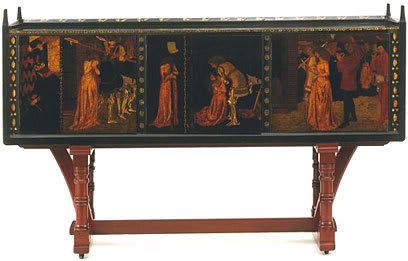
Over the past few weeks I've written quite a few articles on members of the Pre-Raphaelite movement and their work. It occured to me that, although I've mentioned Morris and Company numerous times, I still haven't done a profile of the Company.
Morris, Marshall, Faulkner & Co. (1861-1875) and its successor Morris & Co. (1875-1940) were furnishings and decorative arts manufacturers and retailers founded by designer William Morris. Morris began the venture upon completing the decoration of his home in Bexleyheath known as Red House. Morris had been disappointed to discover that it was nearly impossible to find simple, quality furniture and accessories for his home. As a result, he enlisted the help of his artist friends, Dante Gabriel Rossetti, Edward Burne-Jones and Philip Webb in designing his home's interior. When he was finished decorating, Morris got together with several of his friends, including Ford Madox Brown, Edward Burne-Jones, Charles Faulkner, Dante Gabriel Rossetti, P. P. Marshall, and Philip Webb, and in 1861 they established the firm of Morris, Marshall, Faulkner & Co., dedicated to providing simple handcrafted, medieval inspired designs for home interiors.
The firm set up shop at 8 Red Lion Square, London and was organized with a kiln in the basement, a showroom and offices on the first floor, and a workshop in the attic. The place had the air of a "medieval workshop" and the designs the firm prodcued were intended to "revive a sense of beauty in home life" and "to restore the dignity of art to ordinary household decoration"(Morris, as quoted in Todd, 9). The company was quite successful and wealthy patrons were drawn in by Morris' artistic vision and eccentric genius. Author Henry James was deeply impressed by the artistry of the Company's products, and said of Morris himself that "everything he has and does is superb and beautiful"(Todd, 10).
Morris was both a talented artist and a eager businessman and Morris, Marshall and Falkner experienced a fair amount of commercial success. The firm soon expanded to carry a number of different textile products, including tapestries, decorating fabrics, carpets and embroideries, combined with mural decorations, carvings, stained glass, metalwork, ceramics, furniture and light fixtures.
Morris was also not opposed to exhibiting the work of the company at the International Exhibition of 1862. The firms' exhibit was styled after a Medieval court, featureing a sofa designed by Dante Gabriel Rossetti along with six of Morris' own furniture designs, including the elaborate "St. George's Cabinet" designed by Philip Webb and decorated by Morris in Gilt and vignettes of St. George slaying the dragon (pictured top). Although Art Critics pounced on the Pre-Raphaelites immediately--one critic from The Building News scoffed that the pieces were "no more adapted to the wants of living men, than medieval armour would be to modern warfare, middle-aged cookery to civic feasts, or Norman oaths to an English lady's drawing room"(12). Despite such criticisms, the exhibition led to several lucrative commissions from the Church of England, St. James' Palace and the South Kensington Museum (today known as the Victoria and Albert Museum).
This Lovely Stained Glass Angel Was Designed by Edward Burne-Jones for the Salibury Cathedral in 1878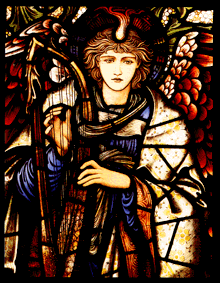
In 1875, the original company disbanded as many of the artists sought to pursue "solo careers" as artists. The company was reformed under Morris' sole guidance as Morris and Co. In 1881 the firm moved production to the Merton Abbey Workshops, which had previously been a silk-weaving factory and printing press on the River Wandle. Morris loved the new shop, which he jokingly referred to as "kindergarten for adults"(108). As the years went on, the popularity of Morris and Company's beautiful products only continued to grow. However, Morris himself was continuously troubled by the fact that his beatiful artwork was unattainable for most of the English people. His vision of affordable, beautiful furnishings remained a dream--only the wealthy could afford to buy his products because the lack of machine production necessitated higher prices. Throughout the history of the firm, Morris resisted introducing machinery, but this made his firm's work very expensive.
Morris and Co. was purchased by Arthur Sanderson of Sanderson and Co. in 1927. Sanderson purchased Morris' designs and continues to print Morris' fabrics and textiles to this day (they even make William Morris paint!). To see their products, visit their website. If you are interested in purchasing Morris and Co. designs, you can search their list of distributors.
Source: Pamela Todd. William Morris and the Arts and Crafts Home. Chronicle Books: San Francisco, 2005).
Cabinet image courtesy Victory and Albert MuseumStained Glass image courtesy William Morris Gallery
For tomorrow: a portrait of Liberty of London, the prestigious Regent street department store that popularized the work of the Arts and Crafts and Art Nouveau designers. Did Liberty do more harm than good by introducing these designs at lower prices and betraying Morris' vision of machine-free production?
Friday, February 8, 2008
Morris and Company
Posted by
Margaret
at
9:54 AM
4
comments
![]()
![]()
Labels: pre-raphaelites, rossetti, william morris
Thursday, February 7, 2008
William Holman Hunt's Lady of Shalott

I have a belief, based on my own experience, that many fans of Pre-Raphaelite art are first drawn in by the story and paintings of the Lady of Shalott. Most people are familiar with Tennyson's beautiful poem, and the images of the Lady of Shalott are iconic. As Grace at The Beautiful Necessity noted a few days ago, images of the Lady of Shalott have inspired a host of artists, writers and musicians (most notably, in my view, Loreena McKennit's fabulous version).
Many of the Pre-Raphaelites painted the ill-fated lady, but today I have decided to include one of my favourite paintings of her from the period, one you may not have seen before.
This painting of the Lady of Shalott was first exhibited in 1905 and was the last (and in my opinion, best) of William Holman Hunt's works. It stands out in my mind for several reasons. First, it shows her at her loom, which I think is the most magical part of the story. Who can forget the first lines of the poem: "there she weaves by night and day a magic web of colours gay." Her wild hair and unraveled yarn foreshadow the disintigration of her life and add an air of drama to the picture that is less pronounced in most of the paintings of her. Plus, I love the wild look in her eye--it certainly seperates her from the majority of other paintings of the Lady of Shalott, most of which are more Ophelia-like (somewhat crazed, but resigned to their fate). Finally, the lady's face is very different from the visages found in William Holman Hunt's other paintings--it is far more lovely and looks as if it was inspired by the drawings of Edward Burne Jones.
The artist, William Holman Hunt is widely regarded today as one of the founding members of the Pre-Raphaelite Brotherhood. Like William de Morgan, he began his artistic training at the Royal Academy, but soon became weary of the conventions of Victorian art. After discovering the writings and art theory of John Ruskin he soon became a full-fledged member of the Pre-Raphaelite Brotherhood. His most famous work of art is The Awakening Conscience--a celebrated, and in my view, rather over-rated piece that demonstrates Hunt's devotion to artistic symbolism. Overall, he is definitely my least favourite of the Pre-Raphaelites. He had a hard time acheiving artistic success during his lifetime because both the press and the public found his works unattractive (a harsh blow for a Pre-Raphaelite artist who was supposed to be creating works of simple beauty). I confess that I'm not overly fond of the majority of his paintings, but I love this particular one.
William Holman Hunt's life was filled with scandal. After his first wife's death, he wanted to marry her sister, but this was illegal in England at the time so he was forced to travel abroad in order to marry her. This in turn caused a major rift within the Pre-Raphaelite Brotherhood, as another member artist, Thomas Woolner, was married to Aice Waugh, the third sister! (source: Wikipedia). To set the record straight, Hunt wrote an autobiographical account of the Brotherhood, entitled Pre-Raphaelitism and the Pre-Raphaelite Brotherhood, that placed special emphasis on his important role within the movement.
Today William Holman Hunt's Lady of Shalott hangs in the Manchester Art Gallery. 
Hunt's most famous work, the Awakening Consicence
Images courtesy Wikipedia Commons
Posted by
Margaret
at
9:46 AM
3
comments
![]()
![]()
Labels: pre-raphaelites, william morris
Wednesday, February 6, 2008
William de Morgan
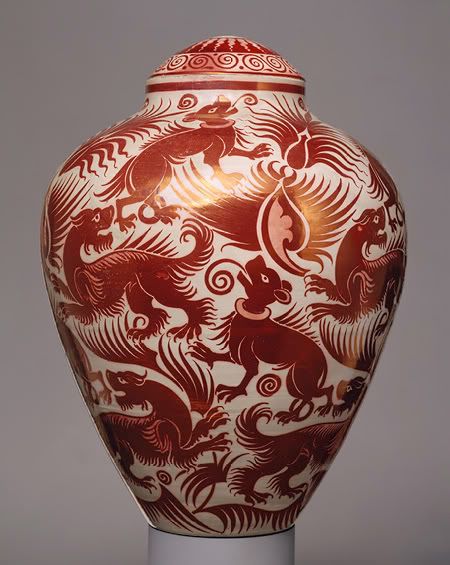
I ran across a picture of this lovely William de Morgan vase on the Metropolitan Museum of Art's website today. The simplicity of his designs is so graphic and modern that it actually reminds me of some of Picasso's ceramic work. Anyway, after doing a bit of browsing, I thought I'd do a small profile on William de Morgan and his contribution to the Arts and Crafts Movement (I've been neglecting ceramic artists so far).
Born in 1839, William de Morgan was a key figure in the Arts and Crafts Movement. He studied at the Royal Academy Schools, but left his studies after meeting William Morris. Shortly afterward, he left his studies to work for William Morris' firm of Morris, Marshall, Faulkner & Co. designing stained glass and painting furniture panels. Through his friendship with Morris, de Morgan came into contact with the Pre-Raphaelite Brotherhood and met his future wife, Evelyn Pickering (Evelyn de Morgan).
De Morgan became an innovator in ceramics after noticing that firing silver paint produced iridecense in stained-glass. De Morgan applied the technique to ceramics and created the now well-known luster glaze (which can be seen on the vase pictured above). De Morgan was especially inspred by Iznik (Turkey) and Persian ceramics, in addition to Italian maiolica and sixteenth-century Hispano-Moresque pottery.
In the 1870s, De Morgan began to focus more on creating decorative tiles. The best example of his work in tiles is perhaps found in his commission to copy Sir Frederic Leighton's collection of Persian tiles for the Arab Hall at Leighton House, London, in 1879. In 1882, he moved his studio to a workshop in Merton Abbey, where he produced and decorated hollowware and continued to experiment with luster glazes.
In 1887, Willilam de Morgan married leading female Pre-Raphaelite artist Evelyn Pickering, who is known today by her married name, Evelyn de Morgan (source: Wikipedia). William assisted his wife with her painting by developing a painting technique that used glycerine to produce bright, clear colours (source: Illusions Gallery).
Although William de Morgan is celebrated today for his contribution to the Arts and Crafts movement, his greateset commercial success during his own lifetime was as a writer, not an artist. The De Morgan Centre reports that although he only started writing when he was 65, his five bestsellers guaranteed a secure retirement for himself and his artist wife, Evelyn.
Like many of the artists of the Pre-Raphaelite movement, including of course his close friend William Morris, de Morgan was multi-talented. Not only was he an amazing ceramic artist and accomplished writer, de Morgan also designed and built his own pottery kilns and studio equipment and was an accomplished chemist (this is not suprising since it takes chemical knowledge in order to develop colouring for glazes). He even developed a new system of gears for bicycles and wrote the Admiralty during the World World War I to suggest how they might go about destroying U-Boats!
(photo courtesy of the Metropolitan Museum of Art website).
Posted by
Margaret
at
9:12 AM
3
comments
![]()
![]()
Labels: pre-raphaelites, william morris
Tuesday, February 5, 2008
Royal School of Needlework

I was looking at some of Paula's lovely embroidery over at The Beauty of Life this morning and it inspired me to do a little research on the Royal School of Needlework (because I would definitely need to take some of their classes if I ever wanted to be able to do embroidery myself!).
The Royal School of Needlework was founded in 1872 by Princess Helena, Queen Victoria's daughter and wife of Prince Christian of Schleswig-Holstein in order to preserve the art of hand embroidery and needlework that was disappearing in the wake of the Industrial Revolution. Not surprisingly, William Morris played a significant role in establishing the school, as did his daughter May and friend Sir Edward Burne-Jones. Morris was hired by the Royal School of Needlework to create some of the first designs used by the school.
The school started out small on Sloane street with space for only about 20 students. By 1903 the school had grown to 150 students and moved to Exhibition Road, close to the Victoria and Albert Museum. The school has been at Hampton Court Palace since 1987 and now features fine views of the Palace gardens (thanks, Wikipedia). Although day classes are offered, the school continues to train young people between the ages of 18 and 26 (alas, I will be too old next year to attend!) with a 3-year apprenticeship in design and all embroidery techniques. Apprentices also learn teaching skills and gain experience in the professional workrooms, which undertake many original commissions and restorations. Beth Russell of Designers Forum, whose designs I constantly recommend on this blog, is probably the most famous student of the school. She's also the reason that I know about the Royal School of Needlework. I read her books religiously (they contain a lot of Arts and Crafts philosophy and history) and she mentions the RSN in several of her books. It sounded like a paradise for fans of handcrafts!
Tracy Franklin is also RSN trained, and her embroidery work is positively stunning. She has published a number of books on embroidery, including a beautiful book on goldwork, New Ideas in Goldwork(she has also written on whitework and advanced embroidery techniques).
Today the Royal School of Needlework has an archive of over 30,000 images covering every period of British history. There are also over 5,000 textile pieces, including 1,000 pieces of lace, plus silkwork, whitework, Jacobean embroidery and many other forms of embroidery and needlework.
The Royal School of Needlework offers "embroidery classes for everyone in the beautiful surroundings of Hampton Court Palace." I will definitely setting some time aside to take one of the RSN classes next time I'm in London! (Perhaps something flashy like goldwork on canvas!). If you happen to be visiting in London, and have some extra time on your hands, try taking one of the day classes available at the school.
Here's what the Royal School of Needlework has to say about their embroidery classes:
In small, friendly class groups with highly skilled and experienced tutors learn to work traditional techniques and discover the subtlety of embroidery and its potential as an art form. The classes are all practical “hands-on” stitching.
One, two or three day Classes are held regularly throughout the year at weekends and on week days during the Easter and summer vacations. Classes cover a wide range of techniques including design and painting.
Class Times: 10.00 am to 4.00pm, with lunch from 1.00pm to 2.00pm
Refreshments: Morning coffee break at about 11.10am. Tea, coffee and soft drinks provided. Bring your own lunch to eat at the RSN or in fine weather picnic in the gardens. The Palace Coffee Shop and Tiltyard Restaurant are available for meals and snacks.
Materials: Designs and packs of materials are provided for all classes. The cost of these kits is additional to the class fee and varies depending on the technique. Kit costs range from approximately £12.00 to £35.00 and the more expensive kits contain metal threads.
Please see the Royal School of Needlework's website for more details
Photo courtesy of Tracy Franklin's website
Posted by
Margaret
at
9:06 AM
6
comments
![]()
![]()
Labels: edward burne-jones, needlework, william morris
Monday, February 4, 2008
News from Nowhere by William Morris
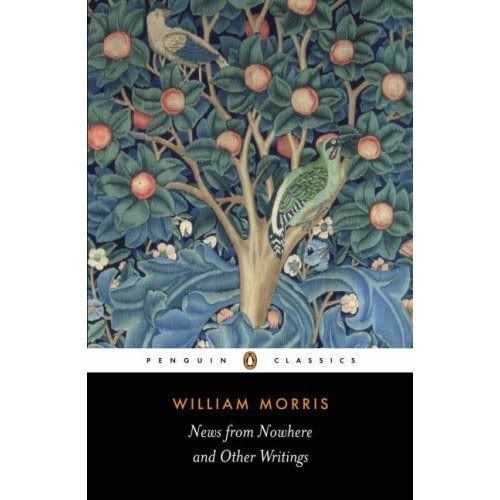
We watched the Superbowl with friends on Sunday, and I have to say that betting on games certainly makes them more exciting! (my husband I wagered a hot chocolate from Starbucks, not exactly high stakes, but enough to keep me interested). I won our little bet (which sort of made me sad--the Patriots have such nice uniforms), but that's life.
This week promises to be quite busy. I am trying to get as much work done on my thesis, but blogging is so much more fun! I'm also trying to make time to read News from Nowhere, William Morris' Utopian novel. So far it's very intersting. It's the first futuristic fantasy I've ever read where the future is neither an apocalyptic nightmare, nor a science fiction inspired workers paradise where machines do everything for us. I guess it's somewhat predictable that Morris envisions a future that looks a lot like the 15th century! All work is creative and pleasurable and people work for the pure joy they take in their labour, rather than for pay. It's a beautiful idea, though I'm not quite sure how it would translate into real life.
The story, set in our time (approximately--they have bridges that were built in 2002 that are supposed to be new) offers a totally different vision of the future than I've ever found in other science fiction, or even in Utopian fantasies. For Morris, the ideal society is pretty much like it was in the Middle Ages, except without a government to spoil everything. People continue to work hard, but they do labour that they enjoy and try to keep the land in as pristine a state as possible (everyone lives in cottages with little gardens. Morris certainly envisioned sustainable architecture as part of his vision of the future--as little land as possible is used and the city of London has basically been allowed to return to the wild, with trees growing where the largest suburban areas of Morris' day were located). Everyone is also well fed and there doesn't seem to be much competition (except over who can produce the most beautiful handicrafts).
Morris wrote News from Nowherein response to Edward Bellamy's Looking Backward: 2000-1887set in roughly the same time period in the future. Bellamy's book took a totally opposite view of the future that is more familiar to today's science fiction readers. In Bellamy's socialist utopian future, technology has led to drastically reduced working hours for and developments like community kitchens for busy housewives help lighten the work load. Everyone retires with full benefits at age 45 (see Wikipedia).
William Morris couldn't stand Edward Bellamy's concept of the future (which is still, I would argue, the prevailing view of where technology is leading us--even though most inventions just leave us with more work to do and less time to do it in). He felt that work was an important part of life and that what mankind really needed to do was to slow down and appreciate living. This reminds me of another great book I took a look at this weekend:In Praise of Slow:How a Worldwide Movement is Challenging the Cult of Speed, by Carl Honoré. The author basically argues that Western society's (and it's not just the West!) obsession with speed has caused us to lose out on a lot of the basic pleasures of life--food, love, leisure, etc. I think he would probably agree with Morris that work is not man's curse, it's the lack of pleasure that we so often take in what we do.
Hmm. Well, that's all for now! I will try to remember to write a bit more about News from Nowhere when I get closer to finishing it!
Posted by
Margaret
at
9:40 AM
5
comments
![]()
![]()
Labels: philosophy, william morris
Saturday, February 2, 2008
Sir Edward Burne Jones' Briar Rose/Sleeping Beauty Paintings
I also love Sir Edward Burne-Jones' paintings. They always have an element of the fantastic in them. I love art that tell a story and so many of his paintings and woodcuts do! This series, entitled "Briar Rose," is among my favourites. I think it also shows his artistic talent at its best and most mature.
Burne-Jones's had a longstanding intrest in the story of Sleeping Beauty (or Briar Rose). He first did a tile panel of the story in 1864. Later, in 180 he did a small series of oil paintings for William Graham. In 1890 (nearly thirty years after the first series) Burne-Jones created a large set of four oil paintings that told the story of Sleeping Beauty (Briar Rose). The series was purchased by Alexander Henderson, who later became the first Lord Faringdon, and installed in Buscot Park, Oxfordshire (where they still hang today). Burne-Jones's interest in the Sleeping Beauty story of the Briar Rose began as early as a tile panel in 1864. A small series of oil paintings for William Graham followed, and then a larger set of four oils, finally completed in 1890 before being bought by Alexander Henderson, later 1st Lord Faringdon, and installed in Buscot Park, Oxfordshire.
Burne-Jones' friend William Morris composed verses to accompany each of the paintings.
One thing that always bothers me about this series is that you never see Briar Rose wake up! Why do you think that is? You see the prince in the first picture, but the rest of the pictures focus on the sleeping kingdom. Perhaps he just wants to leave the final scene to our imaginations? Hmmm. Nevertheless, they are lovely, lovely paintings (you can click on the pictures to see them full size).
The Briar Wood
The fateful slumber floats and flows
About the tangle of the rose.
But lo the fated hand and heart
To rend the slumberous curse apart.
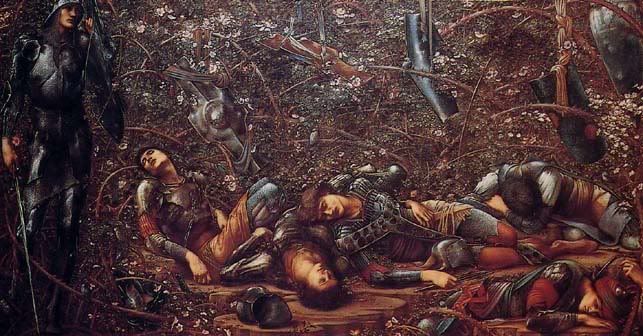
The Council Chamber
The threat of war, the hope of peace
The Kingdom's peril and increase.
Sleep on, and bide the latter day
When fate shall take her chains away.
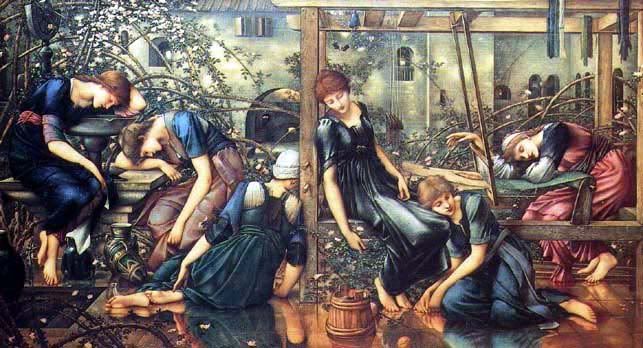
The Garden Court
The maiden pleasance of the land
Knoweth no stir of voice or hand,
No cup the sleeping waters fill,
The restless shuttle lieth still.
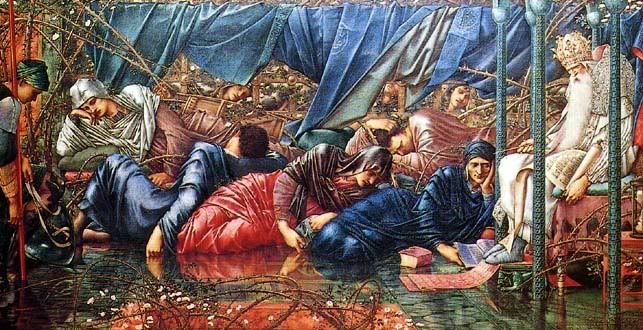
The Rose Bower
Here lies the hoarded love the key
To all the treasure that shall be.
Come, fated hand, the gift to take
And smite the sleeping world awake.
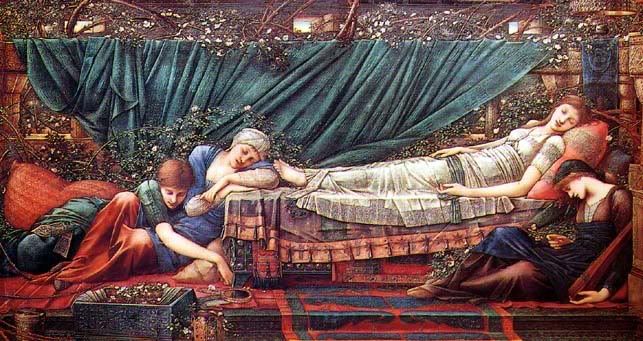
Posted by
Margaret
at
10:35 AM
5
comments
![]()
![]()
Labels: edward burne-jones, fairy tales, poetry, pre-raphaelites, william morris
Friday, February 1, 2008
William Morris Forest Tapestry
I've been waiting on pins and needles (pardon the pun) for my trellis kit to arrive! In the meantime, it never hurts to drool over the other interesting things out there. Today I've been reading about tapestries.
One of William Morris' greatest legacies was his revival of a number of art forms that were on the brink of extinction at the end of the 19th century. Chief among these were his fabulous tapestries. 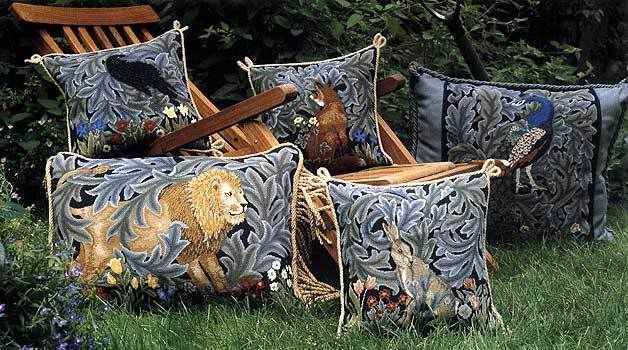 The Forest Tapestry, created in 1887 was designed by Morrs, Philip Webb and John Henry Dearle. It was later woven out of wool and silk on cotten warp in the Merton Abbey workshops by Morris and Co.'s three most senior weavers. It is believed that John Henry Dearle, Morris' most talented assistant and an expert in the art of natural dyes, created the floral details for the tapestry. The animals were drawn by Morris' friend (and designer of Red House), Philip Webb. Morris wrote the inscription that was written across the original: "The Beasts that be in woodland waste, now sit and see nor ride nor haste" (the verse was later published under the title "The Lion" and included in a volume of poetry by Morris entitled Poems by the Way (1891).
The Forest Tapestry, created in 1887 was designed by Morrs, Philip Webb and John Henry Dearle. It was later woven out of wool and silk on cotten warp in the Merton Abbey workshops by Morris and Co.'s three most senior weavers. It is believed that John Henry Dearle, Morris' most talented assistant and an expert in the art of natural dyes, created the floral details for the tapestry. The animals were drawn by Morris' friend (and designer of Red House), Philip Webb. Morris wrote the inscription that was written across the original: "The Beasts that be in woodland waste, now sit and see nor ride nor haste" (the verse was later published under the title "The Lion" and included in a volume of poetry by Morris entitled Poems by the Way (1891).
The design went on to become one of the most popular in the history of Morris and Company. The original now hangs in the Victoria and Albert Museum.
I've also included a photo of Beth Russell's fabulous needlepoint adaptations. I usually can't stand animals in needlepoint designs, but I think these come across as regal and decidedly un-tatty. I especially love how she's displayed them! If you're interested in making one of these cushions yourself, you can purchase it through her website, or find the design in her book, Traditional Needlepoint
In closing, it's been really fun to read everyone's posts on seven things about themselves! Thanks for joining in!
Posted by
Margaret
at
1:28 PM
1 comments
![]()
![]()
Labels: needlework, textiles, william morris

